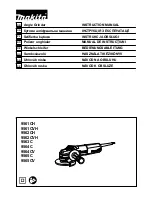
S140131 Mentor-G V3
VII. FLOATS INSTALLATION AND SETUP
If you are considering flying your Mentor-G V3 with optional FLOATS, you may wish to see our
YouTube video at
http://www.youtube.com/watch?v=PgHPmFH4FOc&lr=1&feature=mhum
.
If you are not yet experienced at setting up a float plane, we recommend you review the detailed
floats instructions written for our profile P-47 and P-51 on pages 9 through 11 in the instruction
manual found on-line at
www.maxfordusa.com
.
We offer the following tips to help clarify the instructions packaged with the floats …
1.
The steel struts provide strength and durability. Trace the hole-pattern from
the ends of the aluminum spreaders to drill mounting holes in the struts.
2.
After you have attached the spreaders and struts to the floats, install an extra
layer of plywood inside the fuselage to reinforce the strut mounting points.
3.
Position the floats’
STEP
approx. 1-inch behind the Mentor-G’s center of
gravity. Drill two holes through each front and rear strut and through the
fuselage at approx. 8 1/4 and 21 inches behind the front edge of the fuselage.
4.
Securely attach the struts to the bottom of the fuse-
lage with mounting bolts and blind nuts.
5.
Use an EZ Link Connector to attach one end
of the rudder’s control cable to a spare hole
in the control arm of your Mentor-G V2’s
rudder servo.
6.
Guide the cable in its housing forward from
the rudder servo along the fuselage, the
smoothly bend the cable/housing to the aft-
end of the right-side float, then use 2-piece
plastic clamps and a nylon wire-tie to secure
the cable’s position.
VIII. SETUP AND ADJUSTMENTS
1.
For initial flights set the M
ENTOR
-G
V3’s center of gravity (CG) at approx. 3 3/4-
inches back from the leading edge of the wing. If necessary, move the batteries and/or
add weight to the nose or tail to ensure the CG is correct.
(Hint: Once you have determined the final position for your CG, you may secure both
the engine’s and radio’s batteries in place with double-sided foam tape and pack
some scrap foam rubber into the fuselage’s nose-area around the batteries and fuel
tank to help secure these items against vibration.)
2.
Check the Mylar covering material’s joints and surfaces; if necessary, carefully use a
dedicated covering-material iron to secure the edges and to tighten any loosened areas.
Recheck and retighten from time to time.
3.
Check/adjust servo centering, direction and end-point adjustments. When you pull the
right stick toward you, the elevator should deflect upwards; push the right stick to the
right and the right aileron should deflect upwards and the left aileron should deflect
downwards; push the left stick left and the rudder should deflect to the left as viewed
from the rear of the fuselage. Review your radio’s instruction manual if you require
assistance with any radio-related setup and/or servo-adjustment questions.
4.
For initial flights set all linkages for near-max. possible deflections. If you are using a
Computer Radio: soften the aileron’s and elevator’s control throws by applying 30%
exponential.
Page 9 of 10
Toward the nose




























